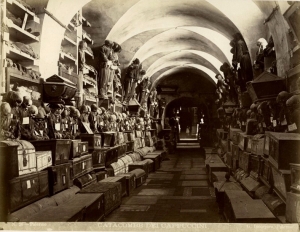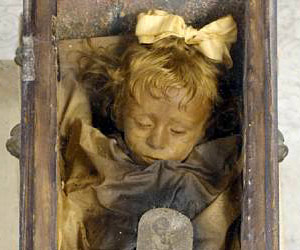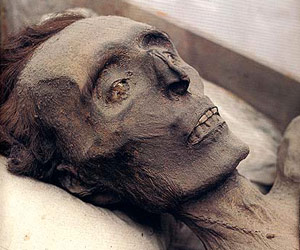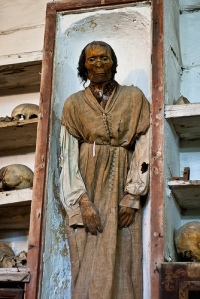 In a northern district of Palermo, surrounded by ugly concrete apartment blocks, hides the church of Santa Maria della Pace where, in tunnels beneath the church the Capuchin monks have been storing the preserved bodies of the dead for nearly 500 years. It all began in 1534 and it was initially only the bodies of the monks who were left in the colatoio (preserving room) to dry out. Later, local prominent families bought their dearly beloved here for storage.
In a northern district of Palermo, surrounded by ugly concrete apartment blocks, hides the church of Santa Maria della Pace where, in tunnels beneath the church the Capuchin monks have been storing the preserved bodies of the dead for nearly 500 years. It all began in 1534 and it was initially only the bodies of the monks who were left in the colatoio (preserving room) to dry out. Later, local prominent families bought their dearly beloved here for storage.
 I’m alone for my visit and it is quite creepy down below. The corridors are literally lined with bodies, some mere skeletons clothed in their Sunday best, others with leathery skin and hair. They are segregated into sections: Clergy, soldiers, professionals, virgins and babies. Indeed, it is the children who are most scary, still wearing their best bonnets. In the furthest corner I find one of the last to be interred in the catacombs and one of the best preserved. 2 year old Rosalia looks like she is asleep in her glass-topped coffin. Doctor Alfredo Salafia had trialled a new process in 1920 which seems to have preserved her features perfectly. Luckily he died before he could work his magic on more cadavers or the catacombs would have ended up looking like a wax museum.
I’m alone for my visit and it is quite creepy down below. The corridors are literally lined with bodies, some mere skeletons clothed in their Sunday best, others with leathery skin and hair. They are segregated into sections: Clergy, soldiers, professionals, virgins and babies. Indeed, it is the children who are most scary, still wearing their best bonnets. In the furthest corner I find one of the last to be interred in the catacombs and one of the best preserved. 2 year old Rosalia looks like she is asleep in her glass-topped coffin. Doctor Alfredo Salafia had trialled a new process in 1920 which seems to have preserved her features perfectly. Luckily he died before he could work his magic on more cadavers or the catacombs would have ended up looking like a wax museum.
 Out of respect for the dead there are signs asking for no photos to be taken, so those illustrating this blog post are taken from the internet.
Out of respect for the dead there are signs asking for no photos to be taken, so those illustrating this blog post are taken from the internet.
 You may be asking yourself if the Capuchin Monks had anything to do with the delicious cappuccino coffee that has become very popular all over the world. Well there is a connection but the exact truth is hard to decipher.
You may be asking yourself if the Capuchin Monks had anything to do with the delicious cappuccino coffee that has become very popular all over the world. Well there is a connection but the exact truth is hard to decipher.
Some people believe it is because the colour of the coffee matched the colour of the monks’ robes. The word ‘cappuccino’ comes from Latin caputium and the Italian form means ‘hood’ or something that covers the head, and it is the hooded robes worn by monks and nuns of the capuchin order that it is named after.
Others think that a monk invented the drink in the 17th century and named it after his order. Legend says that in 1683, following a victory over the Ottomans in the Battle of Vienna, soldiers fighting for Marco d’Aviano, a monk from the Capuchin order, found a hoard of coffee. They found the coffee alone too strong and so they diluted it with cream and honey creating a new version of coffee drink.







